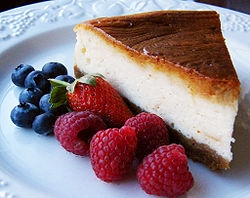Cheesecake
Cheesecake is a dessert consisting of a topping made of soft, fresh cheese (not always cream cheese), usually on a crust or base made from hard biscuits (such as a graham cracker crust), pastry or sponge cake.[1] It may be baked or unbaked. Cheesecake is usually sweetened with sugar and may be flavored or topped with fruit, nuts, fruit sauce and/or chocolate. Various flavours of cheesecake exist, such as lemon, strawberry or toffee. Cream cheese is a soft, mild-tasting cheese with a high fat content. Traditionally, it is made from unskimmed milk enriched with additional cream.[1][2] In the United States of America, it is defined by the US Department of Agriculture as containing at least 33% milk fat (as marketed) with a moisture content of not more than 55%, and a pH range of 4.4 to 4.9.[3] In other countries, it is defined differently and may need a considerably higher fat content.[4] Cream cheese is not naturally matured and is meant to be consumed fresh, and so it differs from other soft cheeses such as Brie and Neufchatel. It is more comparable in taste, texture and production methods to Boursin and Mascarpone.Sponge cake is a cake based on flour (usually wheat flour), sugar, and eggs, sometimes leavened with baking powder which has a firm, yet well aerated structure, similar to a sea sponge. A sponge cake may be produced by either the batter method, or the foam method. Typically the batter method in the U.S. is known as a butter or pound cake while in the U.K. it is known as Madeira cake or Victoria sponge cake. Using the foam method a cake may simply be known as a sponge cake or in the U.K. occasionally whisked sponge, these forms of cake are common in Europe especially in French patisserie.Graham cracker crust is a style of pie crust made from crushed graham crackers. Graham crackers are a sweet American

racker made from unbleached, whole wheat graham flour. The crust is usually flavored and stiffened with butter or vegetable oil and sometimes sugar. Graham cracker crust is a very common type of crust for cheesecakes and cream pies in America. Variations use crushed cookies or Nilla wafers as substitutes for the graham crackers. Toffee is a confection made by caramelizing sugar or molasses (creating inverted sugar) along with butter, and occasionally flour. The mixture is heated until its temperature reaches the hard crack stage of 300 to 310 °F (149 to 154 °C). While being prepared, toffee is sometimes mixed with nuts or raisins. The process of making toffee requires the boiling of ingredients until the mix is stiff enough to be pulled into a shape which holds and has a glossy surface. The resulting mixture will typically be poured into a shallow tray and allowed to cool to form a sheet. Different mixes, processes, and most importantly, temperatures, will result in different textures and hardnesses, from soft and often sticky to a hard, brittle material. A popular variant in the US is English toffee, which is a very buttery toffee often made with almonds. It is available in both chewy and hard versions. Heath bars are a type of candy made with an English toffee core. Although named English toffee it bears little resemblance[citation needed] to the wide range of confectionery known as toffee currently available in the UK. Another variant is honeycomb toffee, which is an aerated version with bubbles introduced by adding baking soda and vinegar while mixing. These react to form carbon dioxide, which is trapped in the highly viscous mixture. In the UK and Canada, the most well known honeycomb candy is the Crunchie bar. The Australian equivalent is the Violet Crumble bar. In New Zealand, this is called hokey pokey.